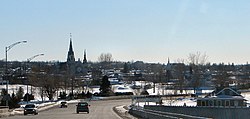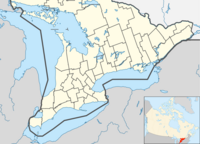Hawkesbury, Ontario
| Hawkesbury | ||
|---|---|---|
| Town (lower-tier) | ||
| Town of Hawkesbury Ville de Hawkesbury (French) |
||

Skyline of Hawkesbury as seen from the Long-Sault Bridge.
|
||
|
||
| Motto: "Vaillant et Veillant" (French) "Valiant and Vigilant" |
||
| Coordinates: 45°36′N 74°36′W / 45.600°N 74.600°WCoordinates: 45°36′N 74°36′W / 45.600°N 74.600°W | ||
| Country |
|
|
| Province |
|
|
| County | Prescott and Russell | |
| Established | 1859 | |
| Government | ||
| • Type | Town | |
| • Mayor | Jeanne Charlebois | |
| • Governing Body | Hawkesbury Town Council | |
| • MP | Francis Drouin (LP) | |
| • MPP | Grant Crack (OLP) | |
| Area | ||
| • Total | 9.62 km2 (3.71 sq mi) | |
| Elevation | 33 m (108 ft) | |
| Population (2016) | ||
| • Total | 10,263 | |
| • Density | 1,067.3/km2 (2,764/sq mi) | |
| Time zone | EST (UTC-5) | |
| • Summer (DST) | EDT (UTC-4) | |
| Postal code | K6A | |
| Area code(s) | 613 | |
| Website | www.hawkesbury.ca | |
Hawkesbury is a town in Eastern Ontario, Canada, on the Ottawa River, near the Quebec-Ontario border.
It lies on the south shore of the Ottawa River about halfway between Downtown Ottawa and Downtown Montreal in United Counties of Prescott and Russell. The Long-Sault Bridge (replacing the Perley Bridge) links it to Grenville, Quebec, to the north. It is located 25 km west of Lachute, Quebec.
Hawkesbury is touted as the third most bilingual town in Ontario, with about 70% of its inhabitants being fluent in English and French, the two official languages of Canada. (Sturgeon Falls is first with 73.4% followed by Hearst at 71%.) 89% of the population is made up of French speaking Franco-Ontarians.
Founded in 1798, Hawkesbury was named after Charles Jenkinson, Baron Hawkesbury.
Thomas Mears and David Pattee, two Americans, entered into a partnership in 1805 to harness the power of the lower Ottawa River and built the first sawmill on the Upper Canada side of the river. The town of Hawkesbury developed around this mill. Mears also built the Union, the Ottawa River's first steamer. Demand for timber during the Napoleonic Wars created a boom. The mill complex continued to grow for at least the next half century, and by 1870 it included 145 different saws and created over 35 million board feet of lumber per year.
...
Wikipedia


